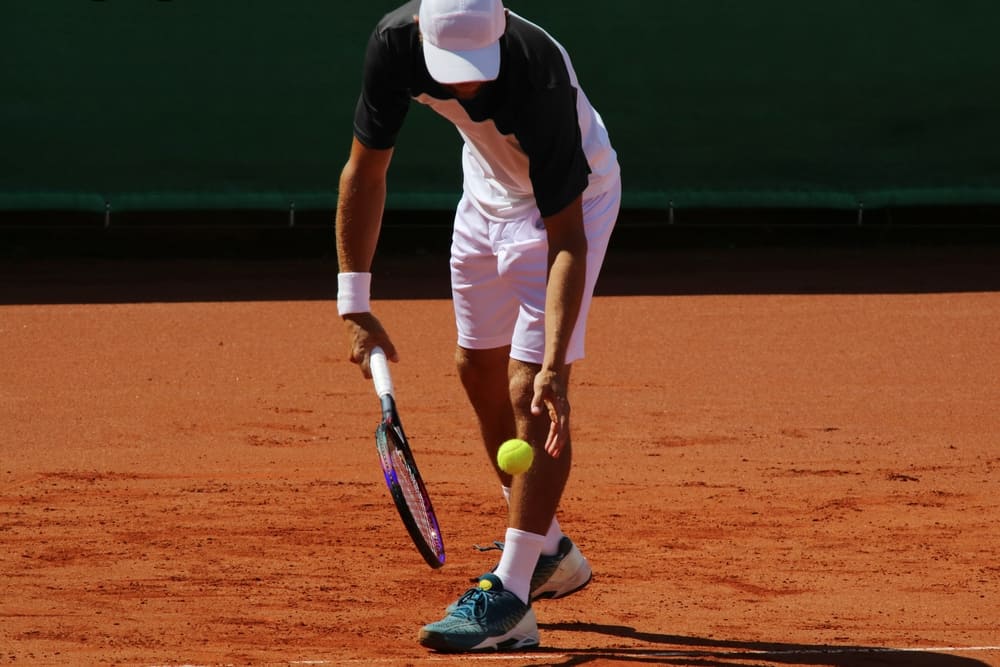There’s so much tension leading up to a serve in tennis. The returning player has to guess where the ball will go and try to make the best of it while the server is trying to win an easy point. Both players usually move quite a bit right up to when the ball is struck. But is moving during the serve in tennis allowed?
Key Takeaway:
Tennis rules allow players on both sides of the net some movement during a serve. The returning player is allowed to move in anticipation of returning the shot as long as it isn’t distracting. The serving player is slightly more restricted and can only make minor movements with their feet.
In the rest of this article, I’ll cover some of the different ways players move during a serve in tennis. By the end, you’ll know what’s allowed and what isn’t.
HEAD's Ti series has long been considered one of the best racquet series for beginners and the Ti S6 tops them all! It's a do-it-all type of racquet at a super affordable price!
Moving Your Feet When Serving in Tennis
Every player sets up for a serve a little bit differently. Some are almost completely still, while others rock back and forth several times.
While some movement is fine, there’s a point where it gets to be too much. To know where that line is, it’s good to consult the International Tennis Federation (ITF) rulebook. There’s one section specifically about moving during a serve.
Rule 18 A states, “During the service motion, the server shall not… Change position by walking or running, although slight movements of the feet are permitted.”
So, players can’t charge or even walk into a serve, but some minor foot movement is allowed as long as they don’t cross the line.
Can You Step on the Line When Serving?
Speaking of that line, what happens when you cross it?
You cannot step on the line when serving in tennis until after striking the ball. This is referred to as a foot fault and can result in the loss of a serve. If a line umpire or chair umpire calls a foot fault, the player loses whichever serve they’re on and moves on to the next one.
It’s best to set up for a serve in tennis at least an inch (2.5 cm) away from the line so that there’s no chance of being called for a foot fault. It will remove potential stress and won’t impact your serve.
Rocking Back and Forth During a Serve
When watching professional tennis you’ll often see players go through the same exact pattern over and over.
Usually, it looks something like this: The player steps up to the court, carefully places their feet behind the baseline, and when they’re ready to serve, they open their stance and toss the ball in the air, rocking back as they bend their knees before finally bringing the rear foot back in to jump into the serve.
That sounds like a lot of movement, doesn’t it? Well, it’s all legal.
As long as both feet aren’t moving and the player’s body isn’t traveling, the player is free to rock as far back as they can bend before jumping into the serve.

Jumping Into a Serve
Speaking of which, jumping into a serve is also legal in tennis. As long as you don’t walk or run into the lead-up to the jump and your feet don’t touch the line, it’s fine.
Players will often land a few feet inside the court after hitting their serve, and you can too.
The only thing to keep in mind is that the jump is actually helping your serve. Some novice players can get into a bad habit of throwing the ball too far out and hitting the ball from an unbalanced position.
It’s better to make your jump more vertical than horizontal.
Other Movements During a Serve
Aside from the mechanics of a serve, there are other movements before the ball is struck that you might be wondering about.
Every player has different habits, but what do the rules allow?
Tossing the Ball Before a Serve
Unless you’re trying to hit an underhand serve, you’ll toss the ball in the air and strike it from as high a point as possible. Now imagine that the wind picks up and moves your ball. It becomes much harder to serve accurately when that happens, so most players will catch it and try again instead.
There’s technically no limit to the number of times you can do this, but umpires may call an infraction for delaying the game if it’s an obvious scheme.
Bouncing the Ball Before a Serve
You can also bounce the ball before hitting a serve, but you’ll want to be more careful with how many times you do it. Some players, like Novak Djokovic, have been known to bounce the ball twenty times or more before finally serving, but if they get the wrong umpire, they might lose the point because of it.
Don’t make the returning player wait more than necessary. It’s good sportsmanship.

Can the Returning Player Move While the Opponent Is Serving?
Finally, we come to the rules for the player on the other side of the net.
The returning player can move while the opponent is serving as long as it’s not too distracting. Most players will lean back and forth to stay loose. Right before the ball is served, they’ll do a short jump to better react to the serve when they land. This is legal as long as it’s not too flashy.
Players returning serve really only get in trouble when they’re obviously trying to throw the serving player off their game. It’s another area in tennis where it’s important to be a good sport.
Moving During the Serve in Tennis – Final Thoughts
In tennis, both the serving and returning players can move during a serve.
For the server, these movements need to be minimal and stay behind the baseline until the ball is struck. For the returning player, they simply have to ensure they’re not hindering their opponent.
If everyone follows those rules, the game should go smoothly, and all players can enjoy a great game.
Sources
- ITF: Rules of Tennis
- Top Speed Tennis: Tennis Serve Stance and Setup
- Tactical Tennis: Serving Mechanics – The Jump
- Tennis 365: Novak Djokovic reveals ball bouncing superstition after starting French Open with a win

Welcome to TheVolleyLlama.com. My name is Keith, I’m just a lover of all sports that involve a racquet, net and a ball. I played competitive high school varsity tennis, love racquetball and my whole family plays pickleball regularly. I started this website to help give people like you the basics to learn these wonderful games.


